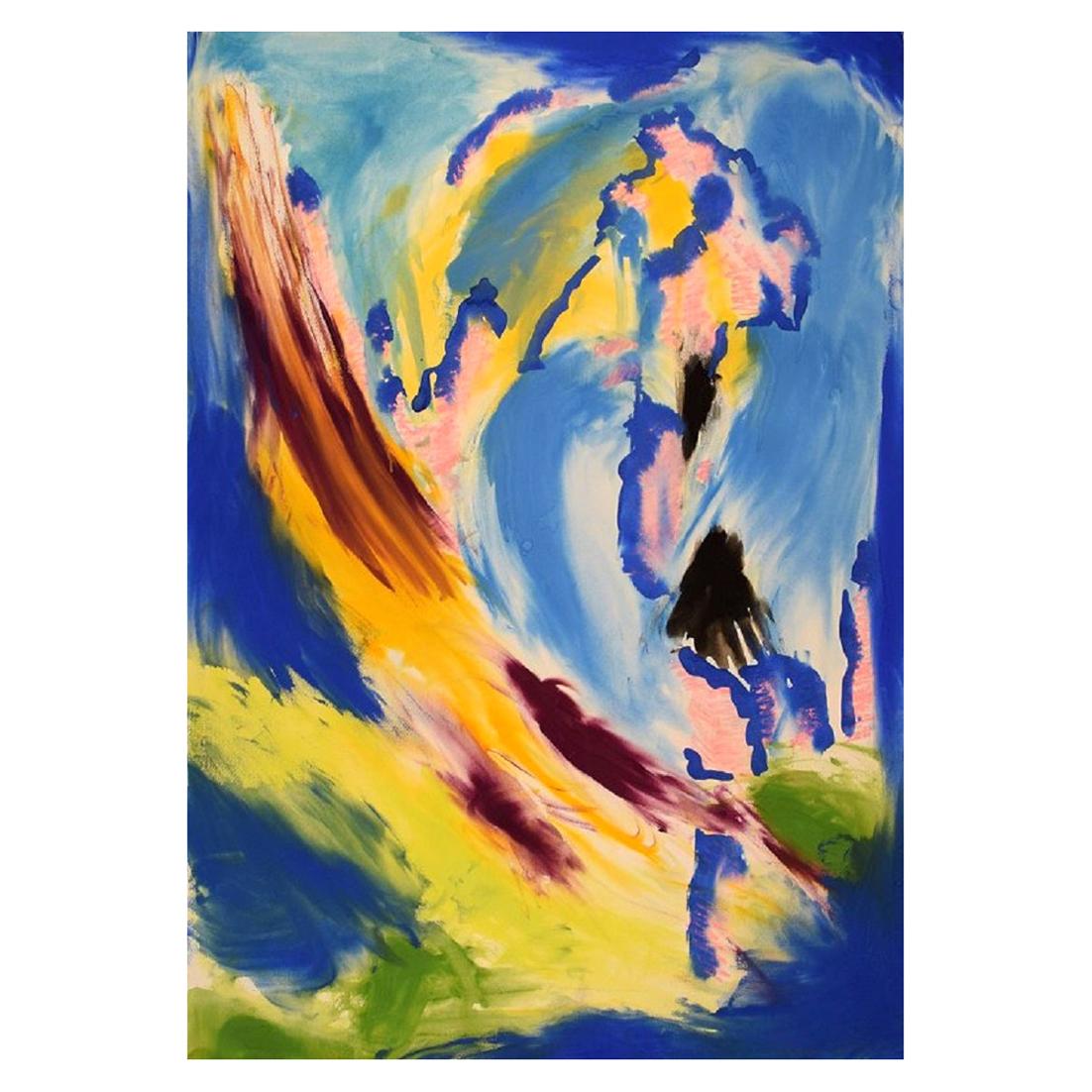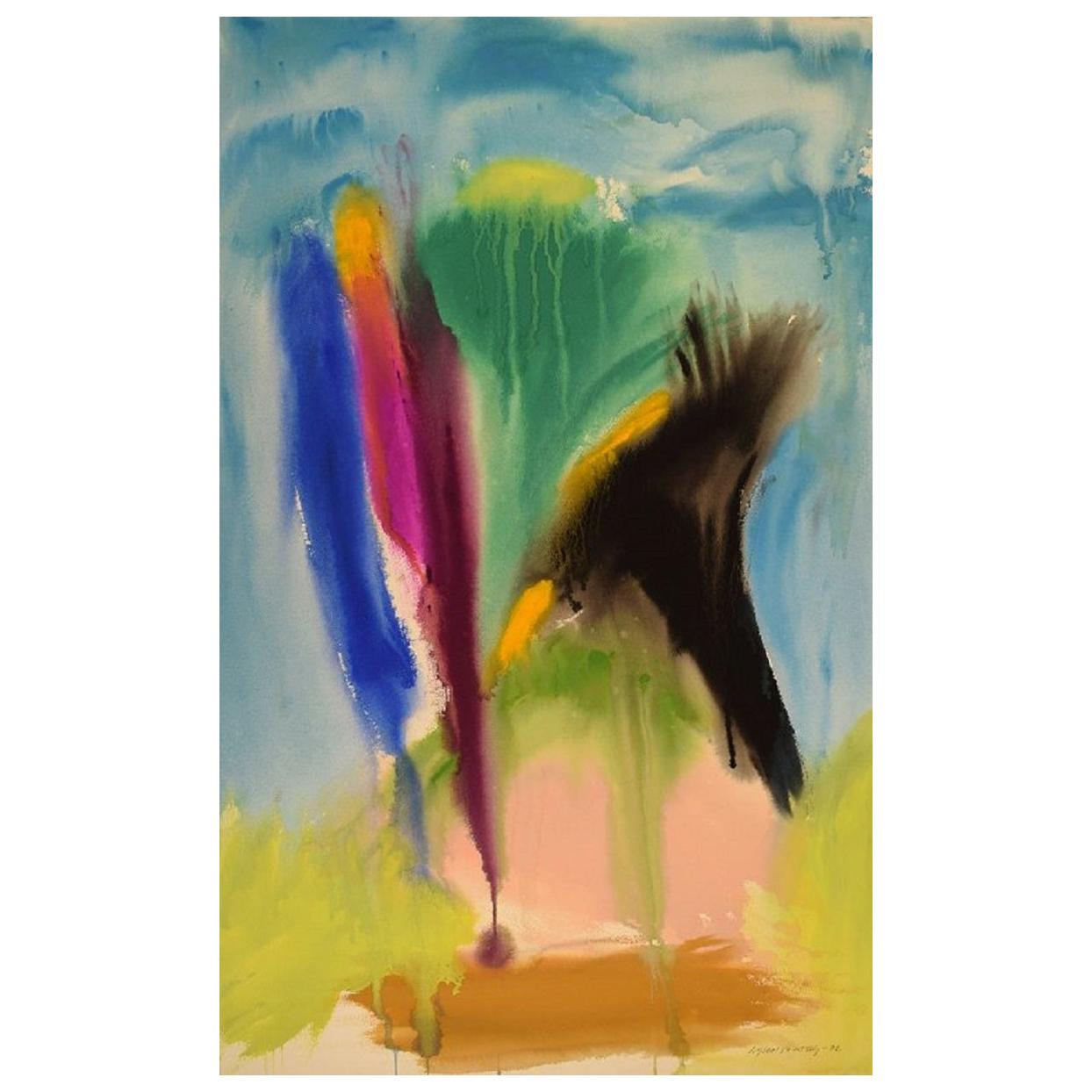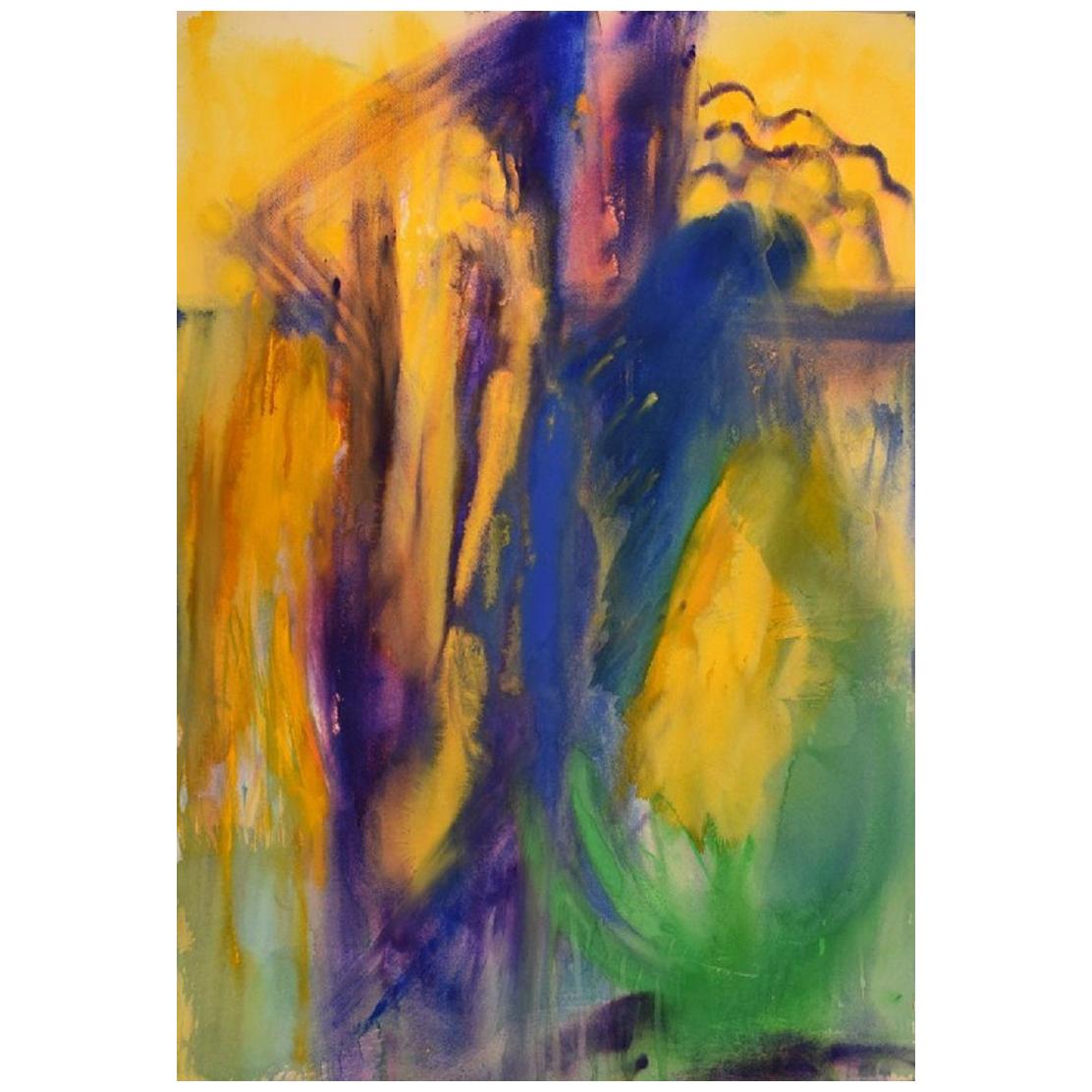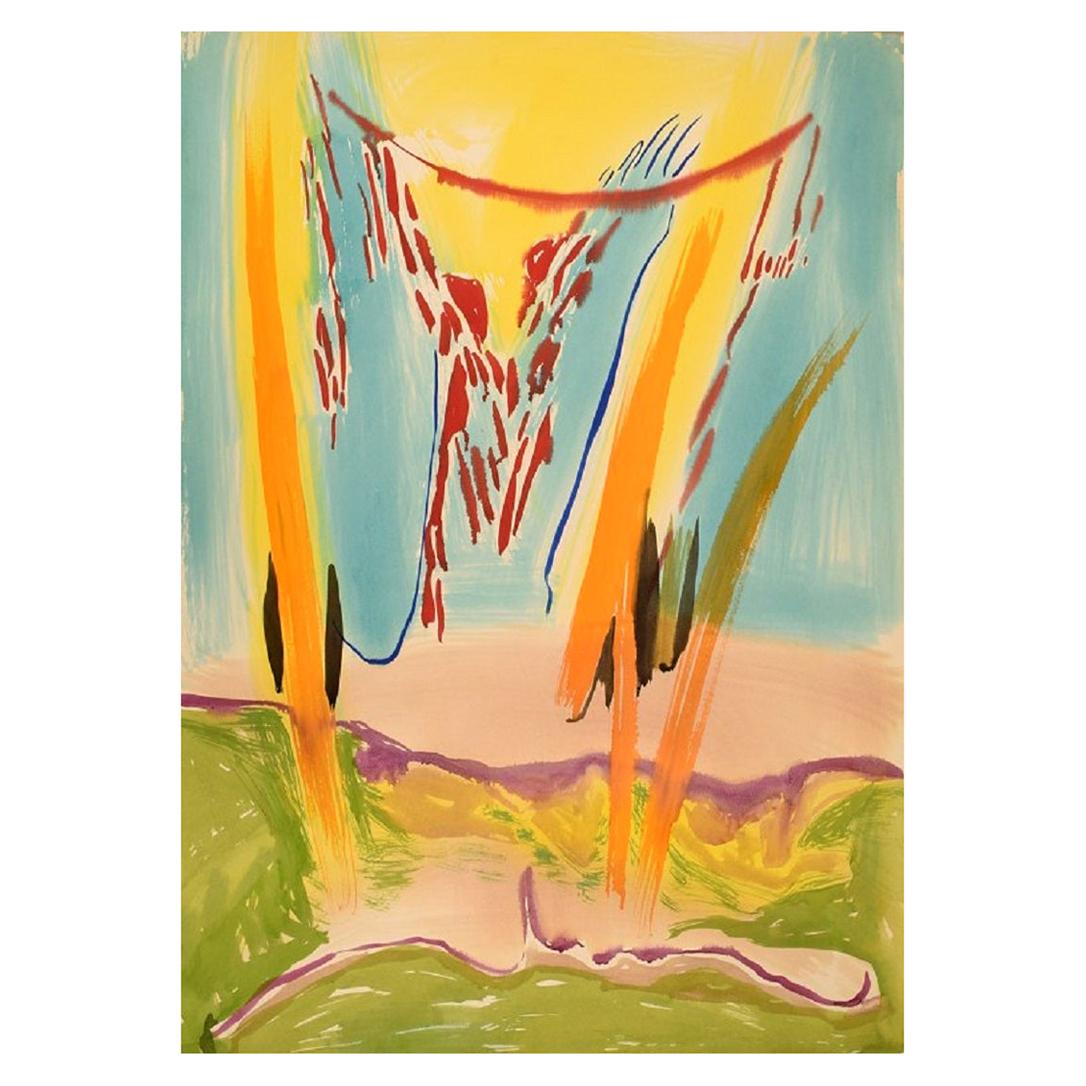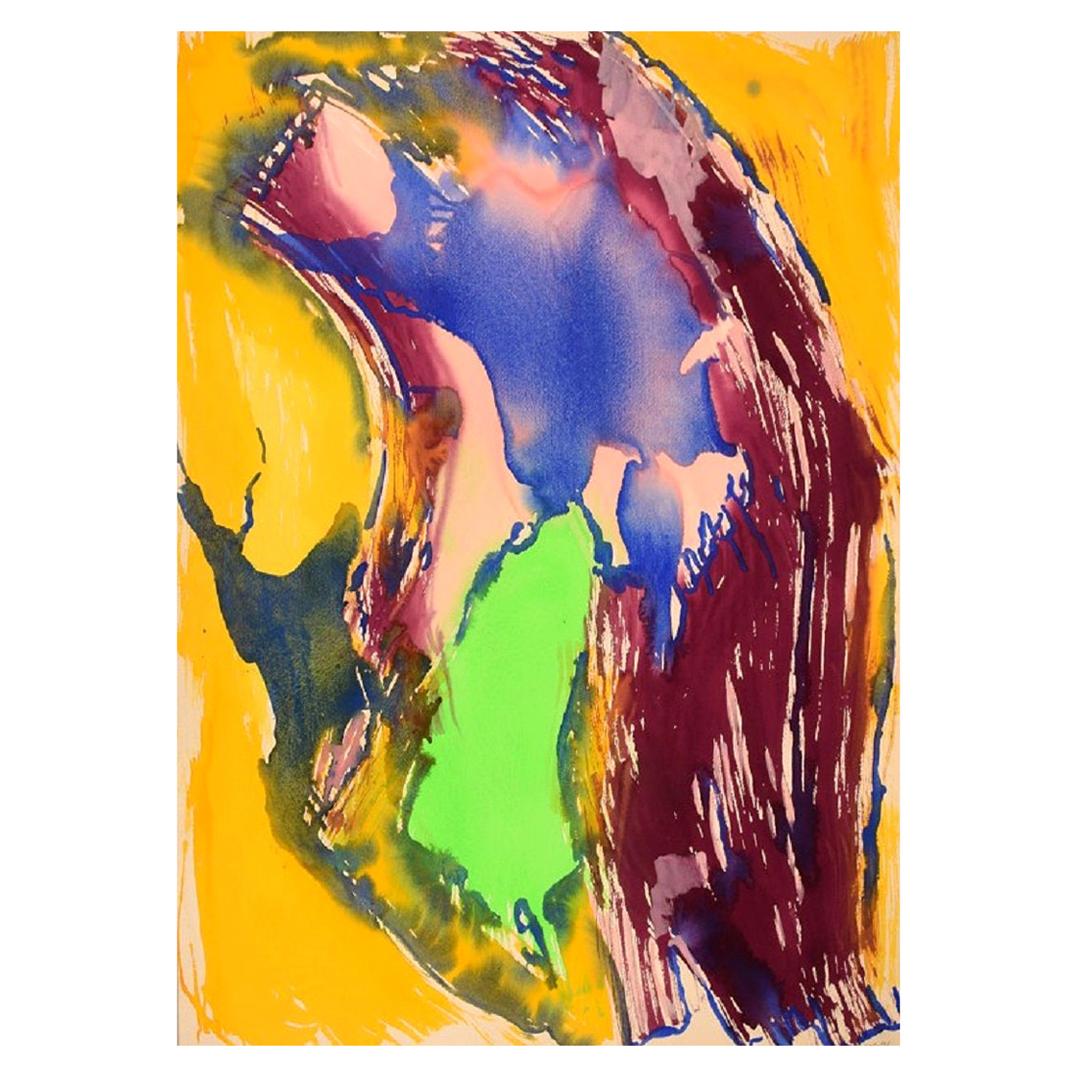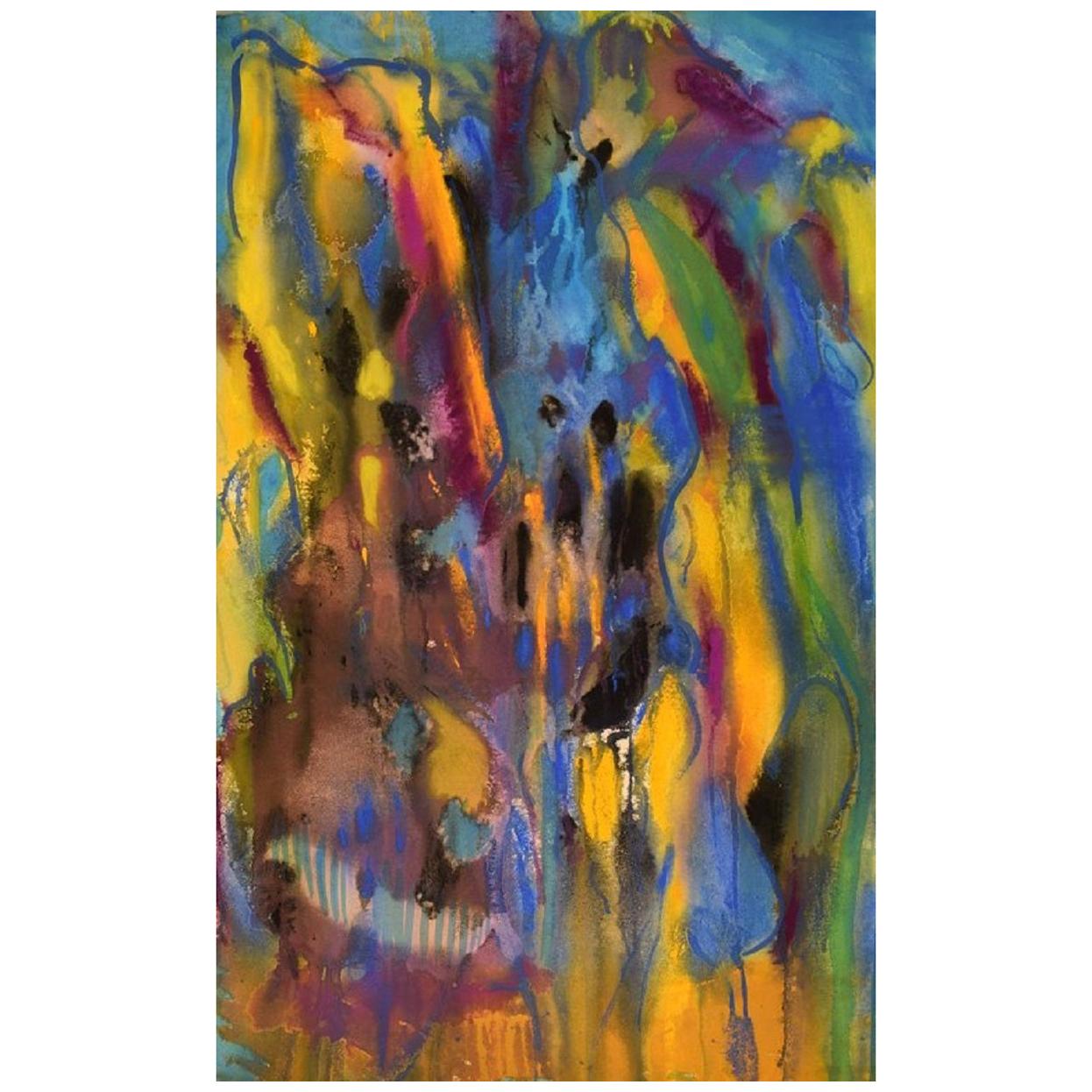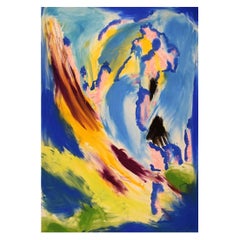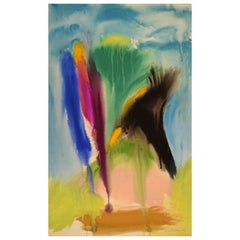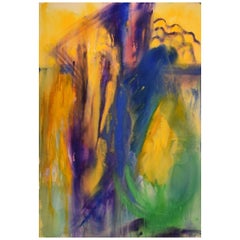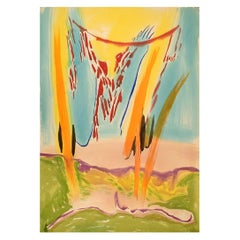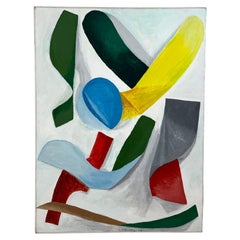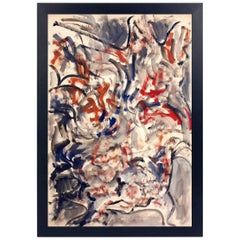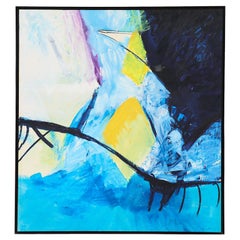Items Similar to Ivy Lysdal, Gouache on Cardboard, Abstract Modernist Painting, 1991
Want more images or videos?
Request additional images or videos from the seller
1 of 6
Ivy Lysdal, Gouache on Cardboard, Abstract Modernist Painting, 1991
$640
£482.62
€558.18
CA$897.92
A$998.09
CHF 523.18
MX$12,189.09
NOK 6,531.57
SEK 6,144.99
DKK 4,166.07
About the Item
Ivy Lysdal, b 1937. Danish ceramist and painter.
Gouache on cardboard.
Abstract modernist painting. Colorful palette.
Dated 1991. Signed.
Measures: 100 x 70 cm.
Provenance: The artist's own studio
Educated at the Arts & Craft School in Copenhagen, (1954-1957).
Employed at Kähler, (1959-1960). After that period, own a ceramic studio in Copenhagen. Her early ceramic works are inspired by study trips in Italy. The later ceramic works have a typical abstract 1970s design. Numerous exhibitions in Denmark and abroad. Worked as a ceramist in the 1960s-1970s.
Ivy Lysdal started as an art painter in the 1980s until today. Her paintings are abstract modernist with a colorful palette.
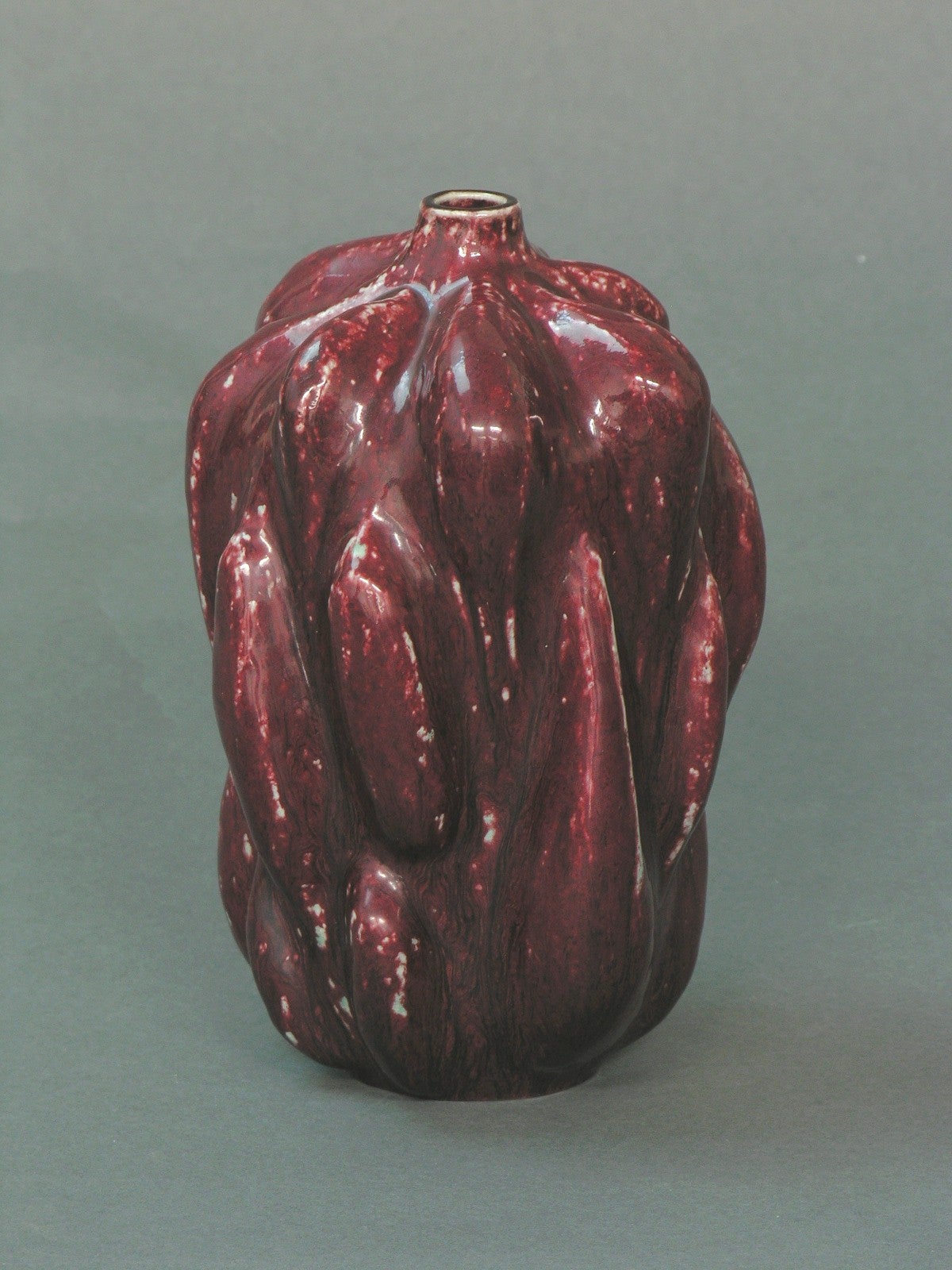
About the Seller
4.8
Gold Seller
Premium sellers maintaining a 4.3+ rating and 24-hour response times
Established in 1999
1stDibs seller since 2014
3,097 sales on 1stDibs
Typical response time: 7 hours
- ShippingRetrieving quote...Shipping from: København, Denmark
- Return Policy
Authenticity Guarantee
In the unlikely event there’s an issue with an item’s authenticity, contact us within 1 year for a full refund. DetailsMoney-Back Guarantee
If your item is not as described, is damaged in transit, or does not arrive, contact us within 7 days for a full refund. Details24-Hour Cancellation
You have a 24-hour grace period in which to reconsider your purchase, with no questions asked.Vetted Professional Sellers
Our world-class sellers must adhere to strict standards for service and quality, maintaining the integrity of our listings.Price-Match Guarantee
If you find that a seller listed the same item for a lower price elsewhere, we’ll match it.Trusted Global Delivery
Our best-in-class carrier network provides specialized shipping options worldwide, including custom delivery.More From This Seller
View AllIvy Lysdal, B 1937, Gouache on Cardboard, Abstract Modernist Painting
Located in København, Copenhagen
Ivy Lysdal, b 1937. Danish ceramist and painter.
Gouache on cardboard.
Abstract modernist painting. Colorful palette.
Dated 1992
Signed.
Measures: 100 x 70 cm.
Provenance: Th...
Category
1990s Danish Modern Paintings
Materials
Other
Ivy Lysdal, Gouache on Cardboard, Abstract Modernist Painting, Dated 1992
Located in København, Copenhagen
Ivy Lysdal, b 1937. Danish ceramist and painter.
Gouache on cardboard.
Abstract modernist painting. Colorful palette.
Dated 1992. Signed.
Measures: 103 x 65.5 cm.
Provenance:...
Category
1990s Danish Modern Paintings
Materials
Other
Ivy Lysdal, Gouache on Cardboard, Abstract Modernist Painting, Late 20th Century
Located in København, Copenhagen
Ivy Lysdal, b 1937. Danish ceramist and painter.
Gouache on cardboard.
Abstract modernist painting. Colorful palette.
Late 20th century.
Measures: 100 x 70 cm.
Provenance: The...
Category
Late 20th Century Danish Modern Paintings
Materials
Other
Ivy Lysdal, Gouache on Cardboard, Abstract Modernist Painting
Located in København, Copenhagen
Ivy Lysdal, b 1937. Danish ceramist and painter.
Gouache on cardboard.
Abstract modernist painting. Colorful palette.
Late 20th century.
Measures: 10...
Category
Late 20th Century Danish Modern Paintings
Materials
Other
Ivy Lysdal, B 1937, Gouache on Cardboard, Abstract Modernist Painting
Located in København, Copenhagen
Ivy Lysdal, b 1937. Danish ceramist and painter.
Gouache on cardboard.
Abstract modernist painting. Colorful palette.
Dated 1991.
Signed.
Measures: 100 x 70 cm.
Provenance: T...
Category
1990s Danish Modern Paintings
Materials
Other
Ivy Lysdal, B 1937, Gouache on Cardboard, Abstract Modernist Painting
Located in København, Copenhagen
Ivy Lysdal, b 1937. Danish ceramist and painter.
Gouache on cardboard.
Abstract modernist painting. Colorful palette.
Late 20th century.
Measures: 103,5 x 64,5 cm.
Provenance:...
Category
Late 20th Century Danish Modern Paintings
Materials
Other
You May Also Like
Abstract Modernist Painting by Irving Schultz D. 1973
Located in Peabody, MA
A modernist composition on canvas of colorful ribboned shapes dated 1973 by the late Bethesda, MD artist Irving Schultz.
Category
Vintage 1970s American Mid-Century Modern Paintings
Materials
Paint
Abstract Painting by Miriam Kubach
By Miriam Kubach
Located in Atlanta, GA
Abstract painting by Miriam Kubach, American, signed and dated 1963. It is executed on paper and has been professionally framed under UV resistant glass in a clean lined black lacque...
Category
Vintage 1960s American Mid-Century Modern Paintings
Materials
Glass, Wood, Paper
Large Abstract Acrylic Painting on Wood Board by Imke Plattel, 1993
Located in Los Angeles, CA
Large abstract acrylic painting on wood board by Imke Plattel, 1993. An abstract in blue with the sensation of water and wind. Plattel was born in Zwolle, The Netherlands in 1960 and...
Category
1990s Dutch Mid-Century Modern Paintings
Materials
Acrylic
1970s Abstract Expressionist Painting on Canvas by Shelley Herman
Located in Raleigh, NC
Vivid color and movement to this original acrylic on canvas. Signed and dated on the verso.
Shelley Herman
1970
"June Breath".
Category
Vintage 1970s North American Modern Paintings
Materials
Canvas, Paint
Modern Expressionist Abstract Painting Signed Mullin
Located in Clarksboro, NJ
This listing is for a Modern Expressionist Abstract Painting. Featuring a vintage wood frame, original expressionist style abstract art with a mixture of colors, and a wire on the ba...
Category
21st Century and Contemporary American Mid-Century Modern Paintings
Materials
Canvas, Paint
$600 Sale Price
20% Off
Rolph Scarlett, Modernist Abstract Composition, Guache on Paper, Ca. 1950’s
By Rolph Scarlett
Located in New York, NY
Artist: Rolph Scarletti (Canadian, 1889 – 1984)
Object: Modernist Abstract Composition
Period: Ca. 1950’s
Medium: Guache on paper, framed
Dimensions (unframed):
Height: 9-1/3”
Width: 12”
Dimensions (framed):
Height: 22-3/4””
Width: 25-3/4”
Rolph Scarlett (Canadian, 1889 – 1984) was a consummate explorer of twentieth-century abstract painting. Never afraid of trying new styles, curious and opinionated, constantly engaged with the world around him while steadfastly aware that he was on his own path and his alone, Scarlett more than once proved to be at the artistic zeitgeist of the eras in which he lived. Exposed very early on to the work of Paul Klee through a chance meeting in Europe with the artist himself, Scarlett took up abstraction with a fervor that never diminished during his long and impressive career. To create something that had never existed before: this was Scarlett’s great cause. And that is what is most obvious when you look at Scarlett’s work—you have never seen anything quite like it.
Scarlett was Canadian-born, came of age in the Midwest, and spent few important years in Hollywood, where he designed stage sets. His work from this early period echoes Klee’s use of color, his confidence in naïve, primitive forms, and his blend of abstraction and figuration. In its flat spatial qualities it prefigures the Indian Space painting of the 1940s by a decade. He moved to New York in 1933 and eventually found his first great patron at the Museum of Non-Objective Painting, directed by Baroness Hilla Rebay and art patron Solomon R. Guggenheim. Guggenheim would collect over 60 works by Scarlett for his collection, more than any other artist outside of Vasily Kandinsky and Rudolf Bauer.
As a frequent exhibitor and lecturer at the Museum of Non-Objective Painting (MNOP), Scarlett honed his sensitive feel for bodies in space and capitalized on his trademark use of bright, vivacious colors into accomplished, perfectly harmonized geometric works. However, Scarlett soon morphed these hard-edged forms into a nuanced expressionistic abstraction which, at its best, seems to be populated by dancing forms that animate the canvases. Along this way he was advised by Rudolf Bauer, the German expatriate and one of the originators of non-objective painting in the teens. Bauer had the idea for the Museum, and Rebay, his champion, had found in Solomon Guggenheim a patron for manifesting it. When Bauer emigrated just before World War II, he wanted to meet Scarlett. The two became friends, and Bauer advised Scarlett on his work over the course of many years. Even in a 1979 interview, Scarlett began to tear up as he recalled his first meeting with Bauer, a man whose work he "worshipped," describing that, "It was a touching moment for me, I’ll tell you."
Scarlett and Rebay also had a close, important relationship, one in which he bore the brunt of her sometimes condescending, if motherly, critiques and admonitions with tolerance and gratefulness. Eventually, though, he had to push back. In a letter from 1951 he writes, "I have noticed with growing amazement that during the past three years you have accepted less and less of my work—and, that same work, which you rejected has been accepted and shown in the best and largest shows all over this country."
This period—the late 1940s to the early 1950s—did in fact correspond to Scarlett’s most critical success, and to a return to the fanciful forms and characters of his pre-war work. At the same time, he found his own rhythm and complexity using a drip style similar to, though denser and more opaque than, the one made famous by Jackson Pollock, who had worked for many years at the MNOP and with whom he shared common influences. In 1949 he had a very well received solo show in 1949 at the Jacques Seligmann Gallery, reviewed very favorably in The New York Times: "The impression made by these paintings is one of originality and strength." He was also included in a juried show "American Painting Today" at the Metropolitan Museum of Art in 1950 and in the Whitney Annual of 1951. The curator for the Whitney show in fact bypassed a selection of Scarlett’s careful geometrics in favor of a new "lyrical" drip painting—one which he describes as having had "a helluva good time" making.
Rebay articulated her loss of control over Scarlett very keenly in one of her last official letters to him: "So your way ended in the horrid jungle it is in now; even a Mr. Pollock’s smearage was not bad enough for you to have a try at; and betraying yourself, you betrayed art and my faith in you, and my present disgrace by my failure to foresee such an outrageous possibility—since you even paint objectively now."
Yet, despite the fact that he was moving in his own direction when the change in leadership took place at the Museum of Non-Objective Painting and Rebay was forced out as director, Scarlett was hit hard. He understood this change rightly as a betrayal by the establishment. Scarlett was a unique individual and soul, and was affected personally and philosophically by the idea that the movement with which Scarlett had aligned his talents seemed to disappear overnight, and his life’s work rendered valueless.
Without the Museum’s support, Scarlett decided eventually to move to the artists’ community of Shady, New York, just outside of Woodstock. He had occasional shows throughout the years, but mostly settled down to regional obscurity. He began making jewelry, which had been his first trade, and it was following a show of his jewelry in 1975 at the Jaro Gallery, that he was rediscovered by Samuel Esses, and his wife Sandy.
Samuel Esses was a successful businessman and an avid collector. He always sought out that which was unusual and, like Scarlett, was ahead of his time in many ways. For example, in 1979, Sam became enthralled with the early graffiti appearing on the New York subway trains. With the sole goal of preserving these groundbreaking yet short lived works of art he was inspired to create "The Esses Studio," a painting warehouse and workshop for graffiti artists to work in a studio, collaborate, and paint on canvas. The biggest names of graffiti writing participated—Futura, Crash, Dondi, Zephyr, and Daze to name a few. The project was well received and provided critical validation at an important time for this alternative form of abstraction to be recognized by the established art world. The success of the "Esses Studio" helped fuel an alternative fire that would propel gallerists and curators to acknowledge other street artists and provide a foundation of acceptance for the early careers of Keith Haring and Jean-Michel Basquiat. It is not a stretch to say that what Esses saw in the graffiti art of the 1970s was very similar to what he saw in 1950s-era Scarletts—something raw, honest, and melding many twentieth century influences into one unique form. Inspired by the importance of the collection and the passion of the collector, Weinstein Gallery...
Category
Vintage 1950s Canadian Mid-Century Modern Paintings
Materials
Paper
More Ways To Browse
Stuart Lloyd
Syrian Oil Painting
18th Century Tibetan Thangka
1940s Modern Painting Male Nude
Albert Ferenz
Antique Theorem
Chinoiserie Diptych
Christian Berard Painting
Cucaro Artist
Cuzqueno Paintings
Don Shearer
Florida Highwaymen Painting
Florida Highwaymen Paintings
Florida Highwaymen
Francisco Rodriguez
Frank Walcutt
Georges Serre
Ghana Movie Poster
